brake light Lexus GS350 2010 Specifications / LEXUS 2010 GS460 GS350 OWNERS MANUAL (OM30C80U)
[x] Cancel search | Manufacturer: LEXUS, Model Year: 2010, Model line: GS350, Model: Lexus GS350 2010Pages: 648, PDF Size: 15.57 MB
Page 3 of 648

1
2
3
4
5
6
7
3
GS_G_U (OM30C80U)
June 29, 2011 10:30 am
2-1. Driving procedures
Driving the vehicle ........................ 126
Engine (ignition) switch .............. 135
Automatic transmission.............. 139
Turn signal lever ............................ 144
Parking brake ................................. 145
Horn.................................................... 146
2-2. Instrument cluster
Gauges and meters ..................... 147
Indicators and warning
lights................................................... 151
Multi-information display........... 154
2-3. Operating the lights and
windshield wipers
Headlight switch ............................ 157
Fog light switch .............................. 160
Windshield wipers and
washer............................................... 161
Headlight cleaner switch ........... 1662-4. Using other driving systems
Cruise control ................................. 167
Dynamic radar cruise
control............................................... 171
Intuitive parking assist ................. 183
Rear view monitor system ......... 196
AVS (Adaptive Variable
Suspension System) .................. 199
Driving assist systems................ 200
PCS
(Pre-Collision System) ........... 207
2-5. Driving information
Cargo and luggage ...................... 214
Vehicle load limits......................... 218
Winter driving tips ........................ 219
Trailer towing ................................. 224
Dinghy towing ............................... 225
3-1. Using the touch screen
Touch screen ................................. 228
Setting the touch screen ........... 235
2When driving
3Interior features
Page 14 of 648
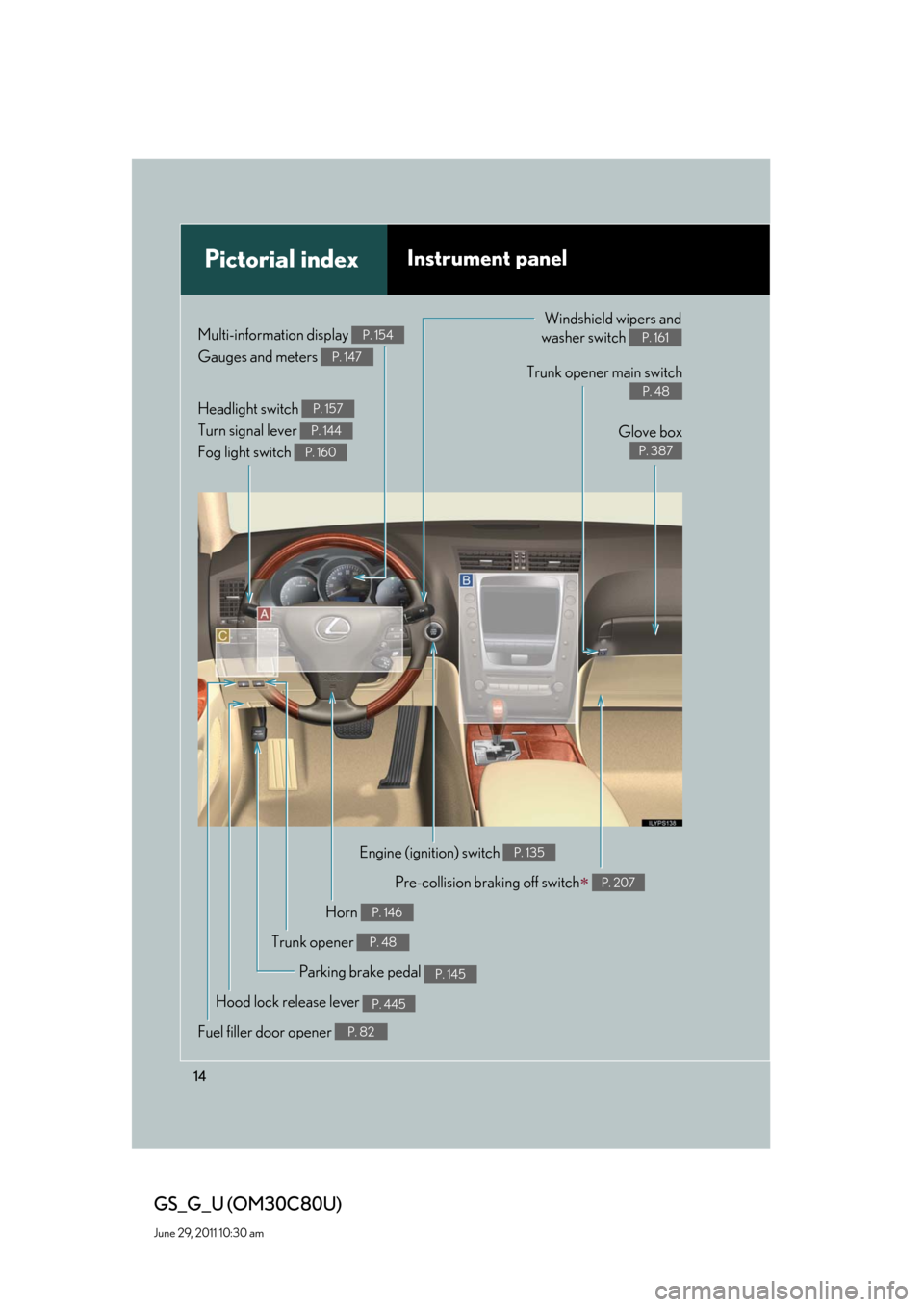
14
GS_G_U (OM30C80U)
June 29, 2011 10:30 am
Pictorial indexInstrument panel
Headlight switch
Turn signal lever
Fog light switch P. 157
P. 144
P. 160
Gauges and meters P. 147
Multi-information display P. 154Windshield wipers and
washer switch
P. 161
Parking brake pedal P. 145
Trunk opener main switch
P. 48
Glove box
P. 387
Hood lock release lever P. 445
Engine (ignition) switch P. 135
Trunk opener P. 48
Fuel filler door opener P. 82
Horn P. 146
Pre-collision braking off switch P. 207
Page 125 of 648
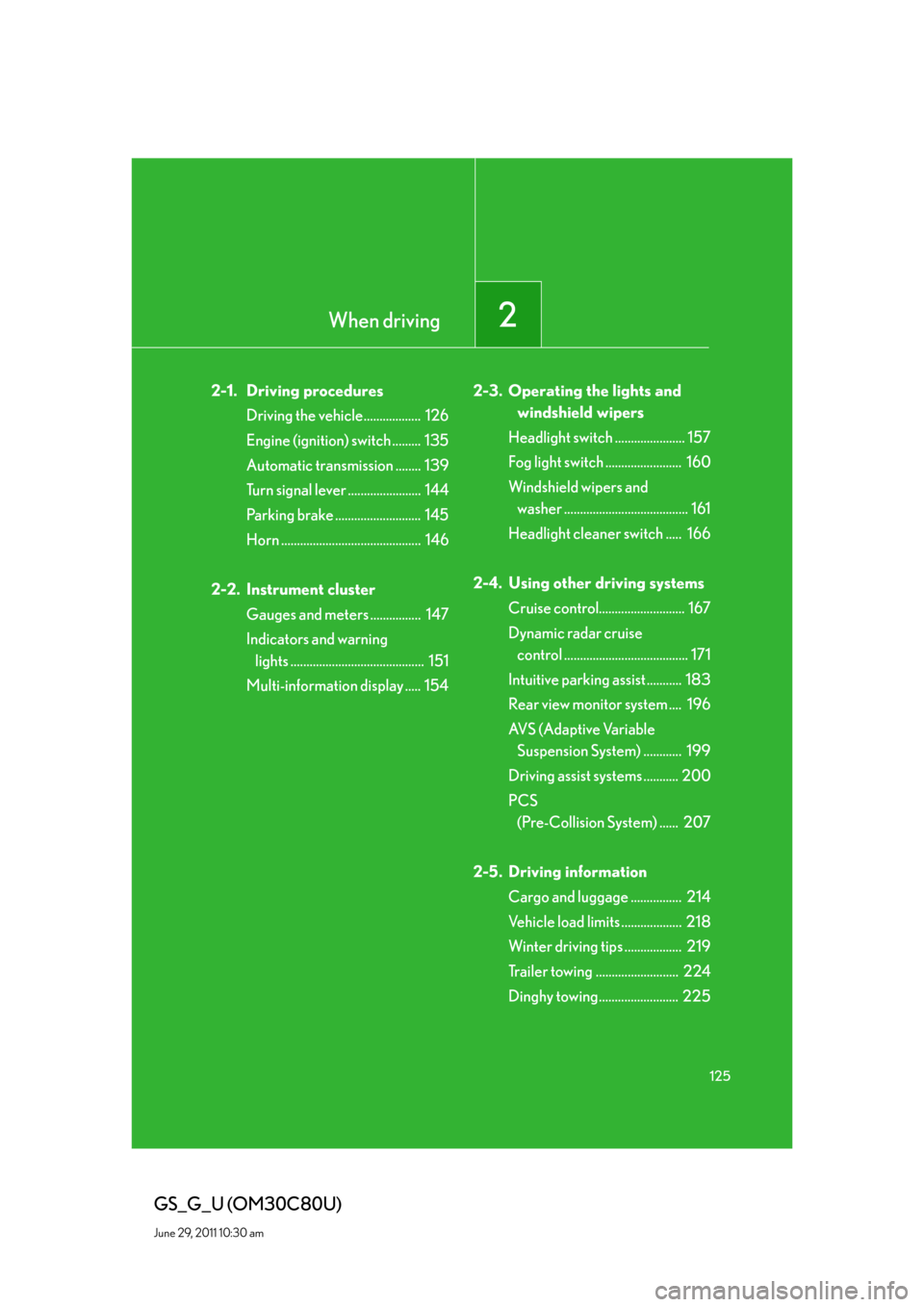
When driving2
125
GS_G_U (OM30C80U)
June 29, 2011 10:30 am
2-1. Driving procedures
Driving the vehicle.................. 126
Engine (ignition) switch ......... 135
Automatic transmission ........ 139
Turn signal lever ....................... 144
Parking brake ........................... 145
Horn ............................................ 146
2-2. Instrument cluster
Gauges and meters ................ 147
Indicators and warning
lights .......................................... 151
Multi-information display ..... 1542-3. Operating the lights and
windshield wipers
Headlight switch ...................... 157
Fog light switch ........................ 160
Windshield wipers and
washer ....................................... 161
Headlight cleaner switch ..... 166
2-4. Using other driving systems
Cruise control........................... 167
Dynamic radar cruise
control ....................................... 171
Intuitive parking assist ........... 183
Rear view monitor system .... 196
AVS (Adaptive Variable
Suspension System) ............ 199
Driving assist systems ........... 200
PCS
(Pre-Collision System) ...... 207
2-5. Driving information
Cargo and luggage ................ 214
Vehicle load limits ................... 218
Winter driving tips .................. 219
Trailer towing .......................... 224
Dinghy towing......................... 225
Page 128 of 648

128
2-1. Driving procedures
GS_G_U (OM30C80U)
June 29, 2011 10:30 am
CAUTION
■When starting the vehicle
Always keep your foot on the brake pedal while stopped with the engine running.
This prevents the vehicle from creeping.
■When driving the vehicle
●Do not drive if you are unfamiliar with the location of the brake and accelerator
pedals to avoid depressing the wrong pedal.
• Accidentally depressing the accelerator pedal instead of the brake pedal will
result in sudden acceleration that may lead to an accident that could result in
death or serious injury.
• When backing up, you may twist your body around, leading to a difficulty in
operating the pedals. Make sure to operate the pedals properly.
• Make sure to keep a correct driving posture even when moving the vehicle
only slightly, allowing you to depress the brake and accelerator pedals prop-
erly.
• Depress the brake pedal using your right foot. Depressing the brake pedal
using your left foot may delay response in an emergency, resulting in an acci-
dent.
●Do not drive the vehicle over or stop the vehicle near flammable materials.
The exhaust system and exhaust gases can be extremely hot. This may cause a
fire if there is any flammable material nearby.
●Do not let the vehicle roll backwards while the shift lever is in a driving position, or
roll forward while the shift lever is in “R”.
Doing so may cause the engine not to operate or lead to poor brake and steering
performance, resulting in an accident or damage to the vehicle.
●If the smell of exhaust is noticed inside the vehicle, open the windows and check
that the trunk is closed.
Large amounts of exhaust in the vehicle can cause driver drowsiness and an acci-
dent, resulting in death or a serious health hazard. Have the vehicle inspected by
your Lexus dealer immediately.
●Do not shift the shift lever to "P" while the vehicle is moving.
Doing so can damage the transmission and may result in a loss of vehicle control.
●Do not shift the shift lever to "R" while the vehicle is moving forward.
Doing so can damage the transmission and may result in a loss of vehicle control.
Page 130 of 648

130
2-1. Driving procedures
GS_G_U (OM30C80U)
June 29, 2011 10:30 am
CAUTION
■When driving on slippery road surfaces
●Sudden braking, acceleration and steering may cause tire slippage and reduce
your ability to control the vehicle, resulting in an accident.
●Sudden changes in engine speed, such as engine braking caused by up-shifting
or down-shifting, may cause the vehicle to skid, resulting in an accident.
●After driving through a puddle, lightly depress the brake pedal to make sure that
the brakes are functioning properly. Wet brake pads may prevent the brakes from
functioning properly. If the brakes on only one side are wet and not functioning
properly, steering control may be affected, resulting in an accident.
■When shifting the shift lever
Be careful not to shift the shift lever with the accelerator pedal depressed.
This may lead to unexpected rapid acceleration of the vehicle that may cause an
accident and result in death or serious injury.
■When the vehicle is stopped
●Do not race the engine.
If the vehicle is in any positions other than “P” or “N” the vehicle may accelerate
suddenly and unexpectedly, and may cause an accident.
●Do not leave the vehicle with the engine on for a long time.
If such a situation cannot be avoided, park the vehicle in an open space and
check that exhaust fumes do not enter the vehicle interior.
●In order to prevent accidents due to the vehicle rolling away, always keep
depressing the brake pedal while the engine is running, and apply the parking
brake as necessary.
●If the vehicle is stopped on an incline, in order to prevent accidents caused by the
vehicle rolling forward or backward, always depress the brake pedal and securely
apply the parking brake as needed.
●Avoid revving or racing the engine. Running the engine at high speed while the
vehicle is stopped may cause the exhaust system to overheat, which could result
in a fire if combustible material is nearby.
Page 131 of 648
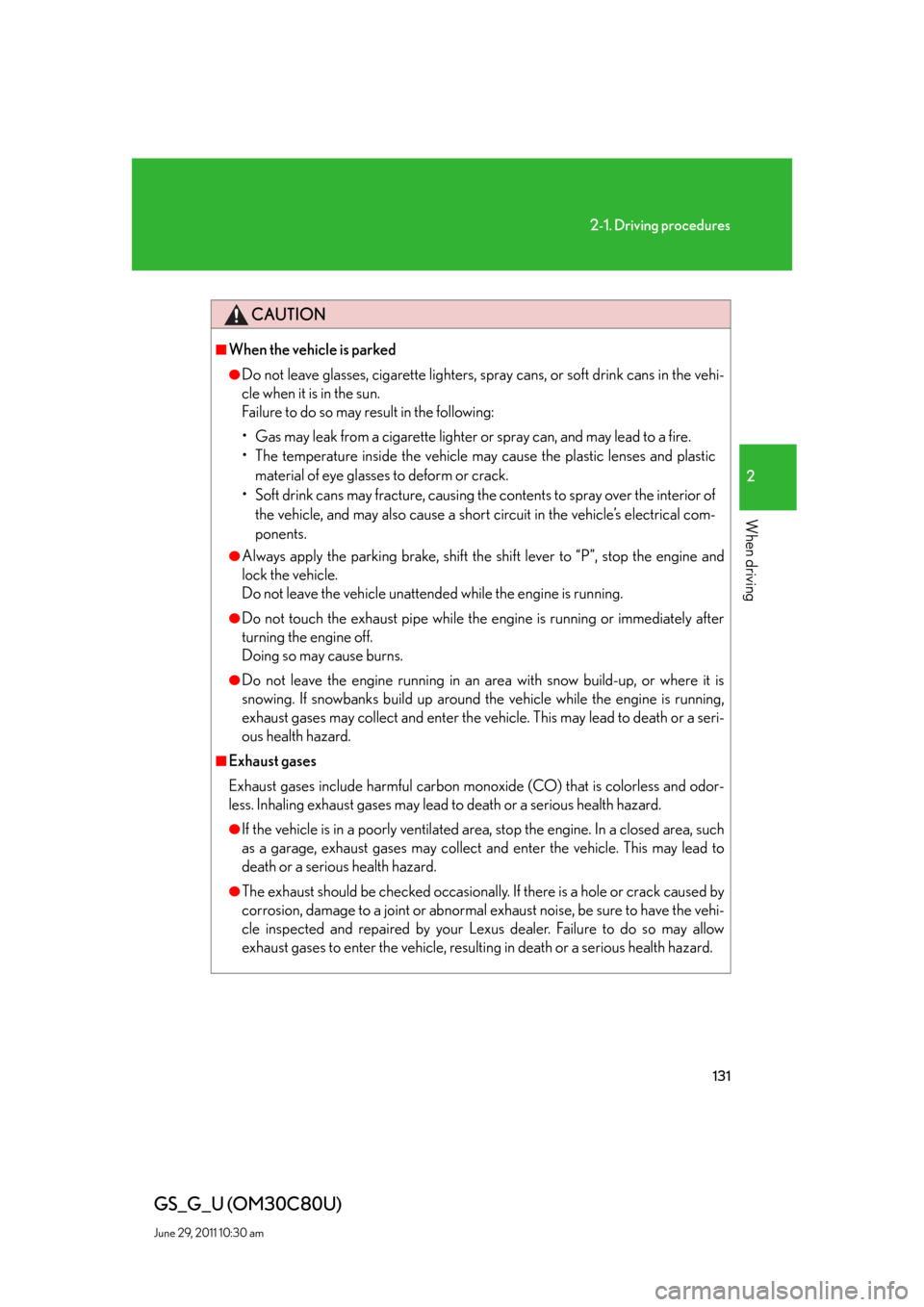
131
2-1. Driving procedures
2
When driving
GS_G_U (OM30C80U)
June 29, 2011 10:30 am
CAUTION
■When the vehicle is parked
●Do not leave glasses, cigarette lighters, spray cans, or soft drink cans in the vehi-
cle when it is in the sun.
Failure to do so may result in the following:
• Gas may leak from a cigarette lighter or spray can, and may lead to a fire.
• The temperature inside the vehicle may cause the plastic lenses and plastic
material of eye glasses to deform or crack.
• Soft drink cans may fracture, causing the contents to spray over the interior of
the vehicle, and may also cause a short circuit in the vehicle’s electrical com-
ponents.
●Always apply the parking brake, shift the shift lever to “P”, stop the engine and
lock the vehicle.
Do not leave the vehicle unattended while the engine is running.
●Do not touch the exhaust pipe while the engine is running or immediately after
turning the engine off.
Doing so may cause burns.
●Do not leave the engine running in an area with snow build-up, or where it is
snowing. If snowbanks build up around the vehicle while the engine is running,
exhaust gases may collect and enter the vehicle. This may lead to death or a seri-
ous health hazard.
■Exhaust gases
Exhaust gases include harmful carbon monoxide (CO) that is colorless and odor-
less. Inhaling exhaust gases may lead to death or a serious health hazard.
●If the vehicle is in a poorly ventilated area, stop the engine. In a closed area, such
as a garage, exhaust gases may collect and enter the vehicle. This may lead to
death or a serious health hazard.
●The exhaust should be checked occasionally. If there is a hole or crack caused by
corrosion, damage to a joint or abnormal exhaust noise, be sure to have the vehi-
cle inspected and repaired by your Lexus dealer. Failure to do so may allow
exhaust gases to enter the vehicle, resulting in death or a serious health hazard.
Page 158 of 648
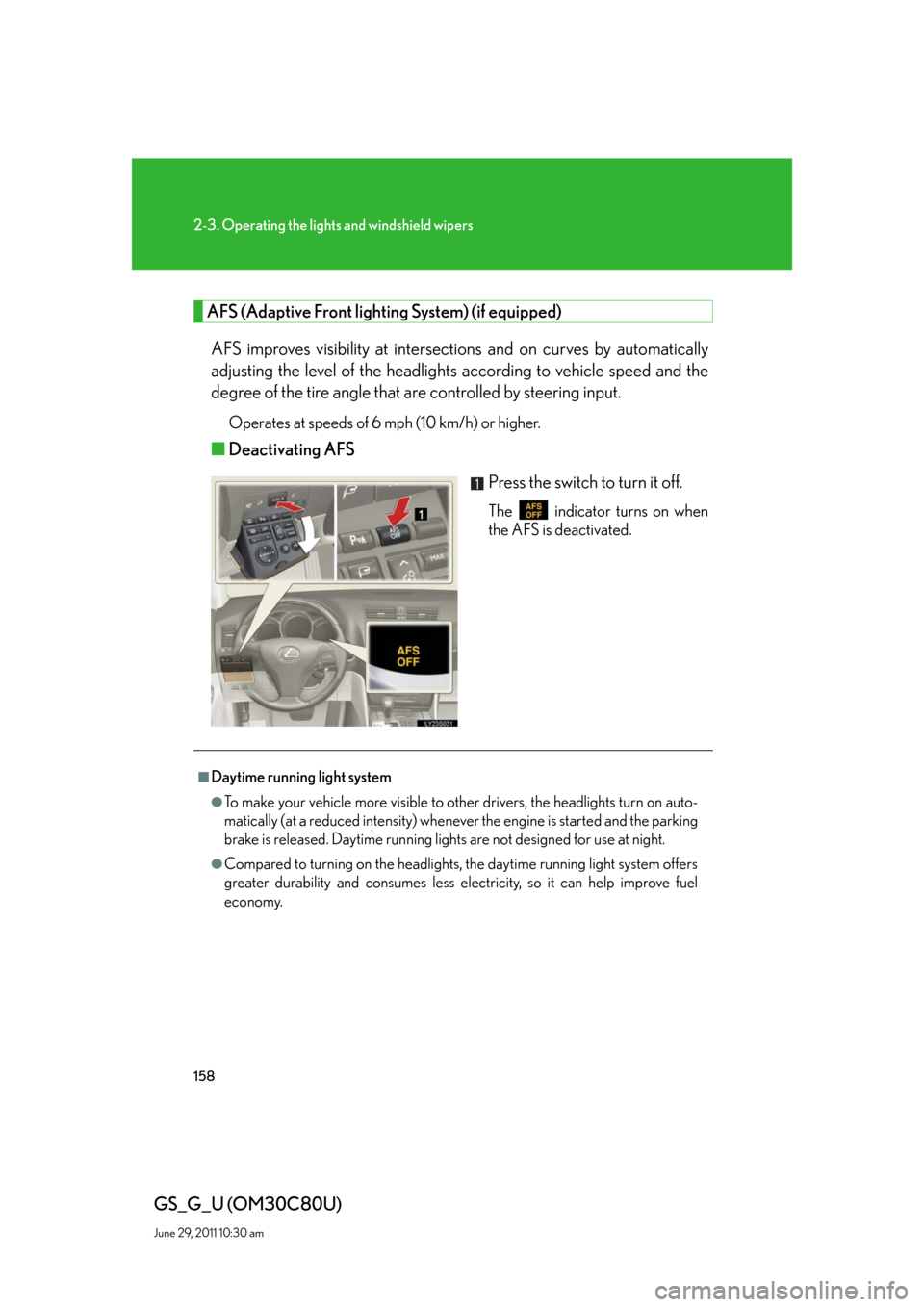
158
2-3. Operating the lights and windshield wipers
GS_G_U (OM30C80U)
June 29, 2011 10:30 am
AFS (Adaptive Front lighting System) (if equipped)
AFS improves visibility at intersections and on curves by automatically
adjusting the level of the headlights according to vehicle speed and the
degree of the tire angle that are controlled by steering input.
Operates at speeds of 6 mph (10 km/h) or higher.
■Deactivating AFS
Press the switch to turn it off.
The indicator turns on when
the AFS is deactivated.
■Daytime running light system
●To make your vehicle more visible to other drivers, the headlights turn on auto-
matically (at a reduced intensity) whenever the engine is started and the parking
brake is released. Daytime running lights are not designed for use at night.
●Compared to turning on the headlights, the daytime running light system offers
greater durability and consumes less electricity, so it can help improve fuel
economy.
Page 168 of 648
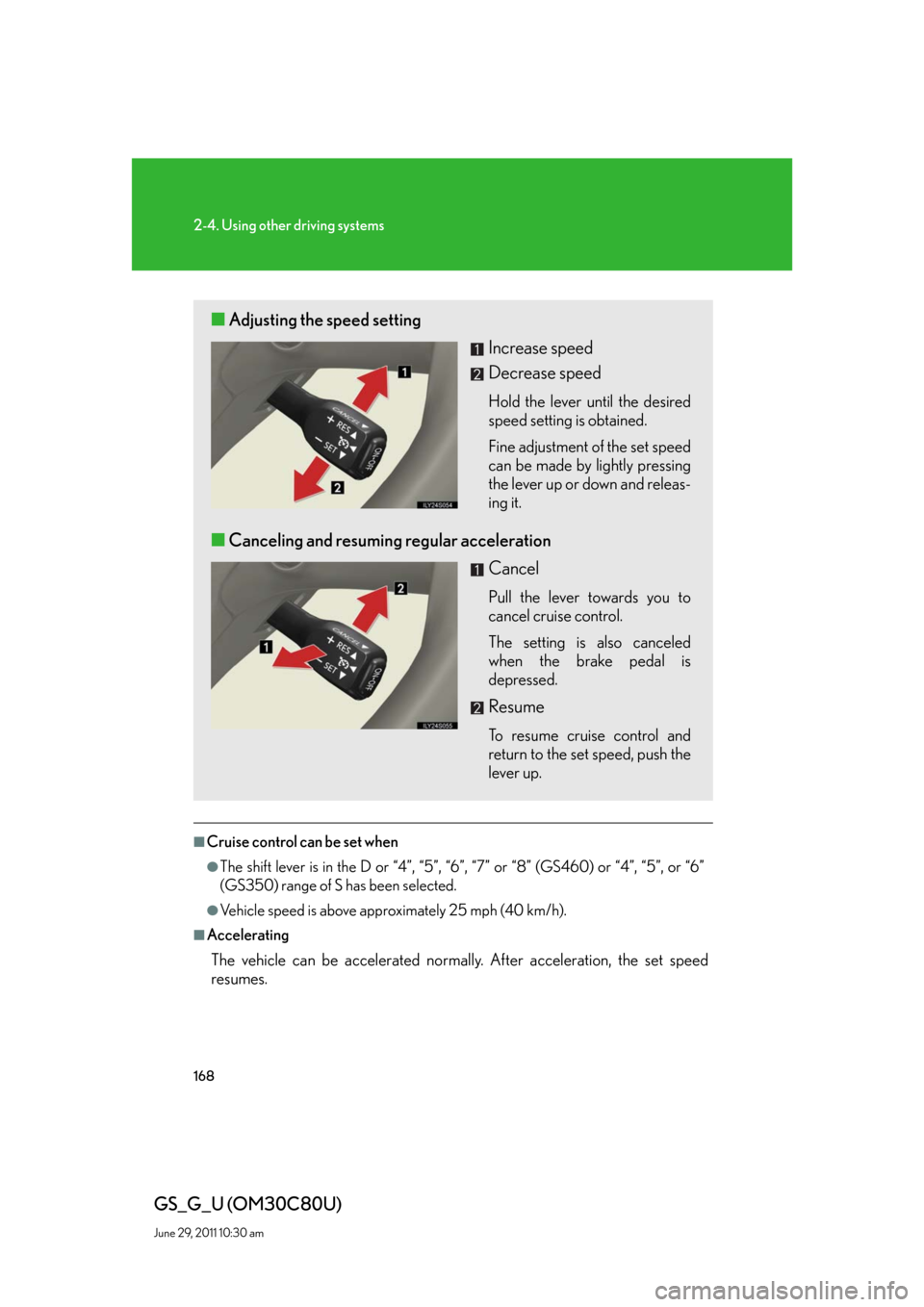
168
2-4. Using other driving systems
GS_G_U (OM30C80U)
June 29, 2011 10:30 am
■Cruise control can be set when
●The shift lever is in the D or “4”, “5”, “6”, “7” or “8” (GS460) or “4”, “5”, or “6”
(GS350) range of S has been selected.
●Vehicle speed is above approximately 25 mph (40 km/h).
■Accelerating
The vehicle can be accelerated normally. After acceleration, the set speed
resumes.
■Adjusting the speed setting
Increase speed
Decrease speed
Hold the lever until the desired
speed setting is obtained.
Fine adjustment of the set speed
can be made by lightly pressing
the lever up or down and releas-
ing it.
■Canceling and resuming regular acceleration
Cancel
Pull the lever towards you to
cancel cruise control.
The setting is also canceled
when the brake pedal is
depressed.
Resume
To resume cruise control and
return to the set speed, push the
lever up.
Page 182 of 648
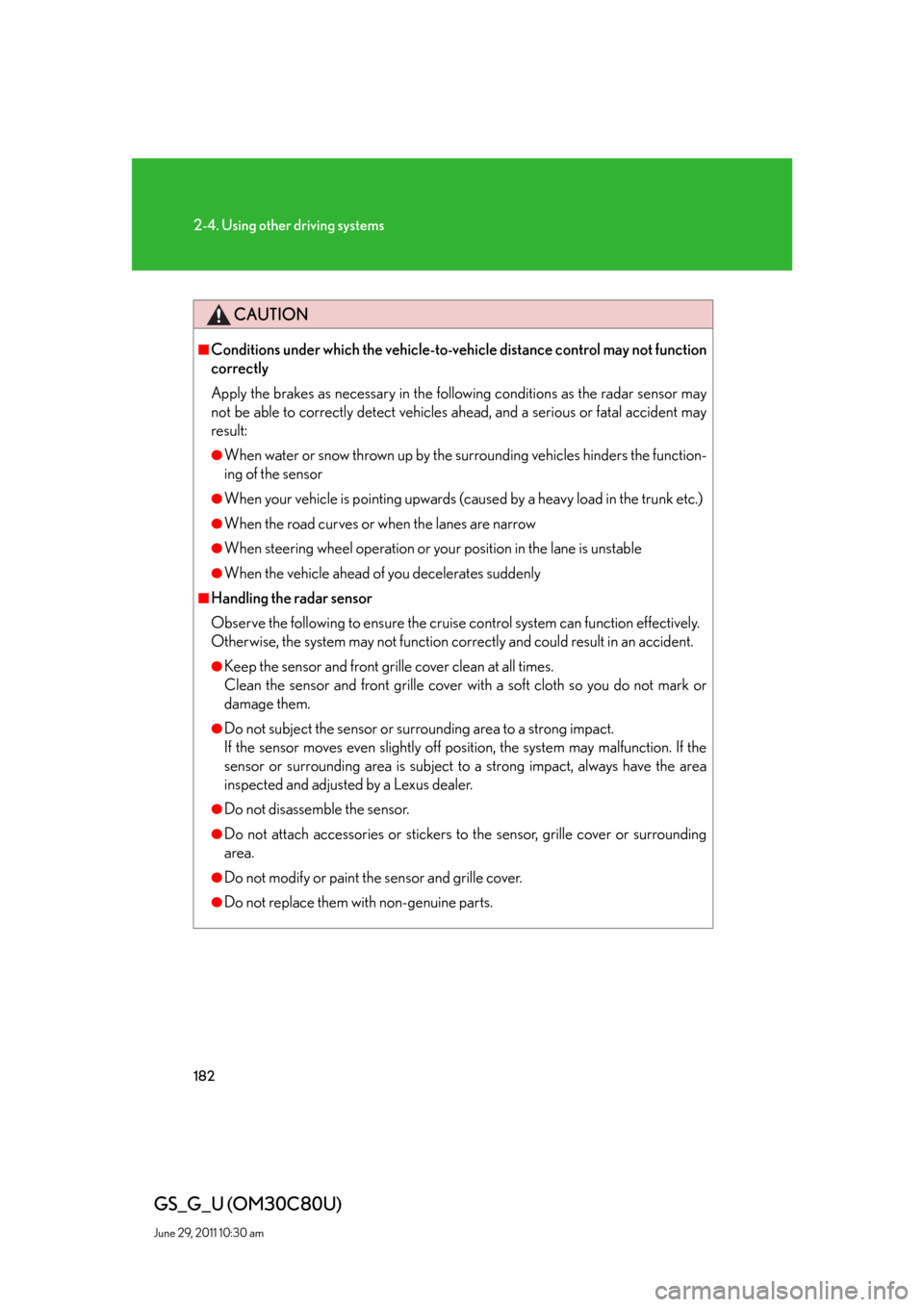
182
2-4. Using other driving systems
GS_G_U (OM30C80U)
June 29, 2011 10:30 am
CAUTION
■Conditions under which the vehicle-to-vehicle distance control may not function
correctly
Apply the brakes as necessary in the following conditions as the radar sensor may
not be able to correctly detect vehicles ahead, and a serious or fatal accident may
result:
●When water or snow thrown up by the surrounding vehicles hinders the function-
ing of the sensor
●When your vehicle is pointing upwards (caused by a heavy load in the trunk etc.)
●When the road curves or when the lanes are narrow
●When steering wheel operation or your position in the lane is unstable
●When the vehicle ahead of you decelerates suddenly
■Handling the radar sensor
Observe the following to ensure the cruise control system can function effectively.
Otherwise, the system may not function correctly and could result in an accident.
●Keep the sensor and front grille cover clean at all times.
Clean the sensor and front grille cover with a soft cloth so you do not mark or
damage them.
●Do not subject the sensor or surrounding area to a strong impact.
If the sensor moves even slightly off position, the system may malfunction. If the
sensor or surrounding area is subject to a strong impact, always have the area
inspected and adjusted by a Lexus dealer.
●Do not disassemble the sensor.
●Do not attach accessories or stickers to the sensor, grille cover or surrounding
area.
●Do not modify or paint the sensor and grille cover.
●Do not replace them with non-genuine parts.
Page 201 of 648
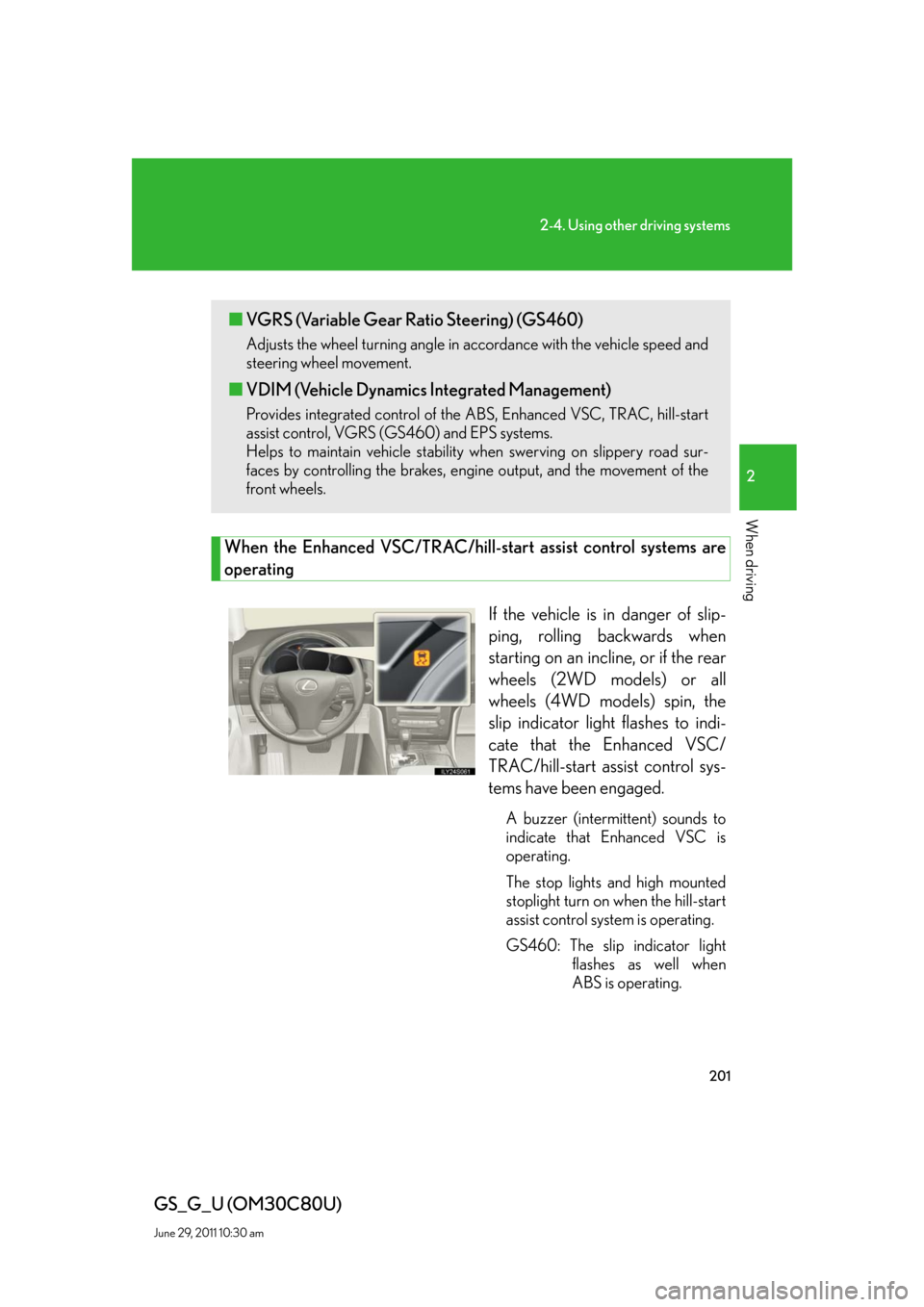
201
2-4. Using other driving systems
2
When driving
GS_G_U (OM30C80U)
June 29, 2011 10:30 am
When the Enhanced VSC/TRAC/hill-start assist control systems are
operating
If the vehicle is in danger of slip-
ping, rolling backwards when
starting on an incline, or if the rear
wheels (2WD models) or all
wheels (4WD models) spin, the
slip indicator light flashes to indi-
cate that the Enhanced VSC/
TRAC/hill-start assist control sys-
tems have been engaged.
A buzzer (intermittent) sounds to
indicate that Enhanced VSC is
operating.
The stop lights and high mounted
stoplight turn on when the hill-start
assist control system is operating.
GS460: The slip indicator light
flashes as well when
ABS is operating.
■VGRS (Variable Gear Ratio Steering) (GS460)
Adjusts the wheel turning angle in accordance with the vehicle speed and
steering wheel movement.
■VDIM (Vehicle Dynamics Integrated Management)
Provides integrated control of the ABS, Enhanced VSC, TRAC, hill-start
assist control, VGRS (GS460) and EPS systems.
Helps to maintain vehicle stability when swerving on slippery road sur-
faces by controlling the brakes, engine output, and the movement of the
front wheels.